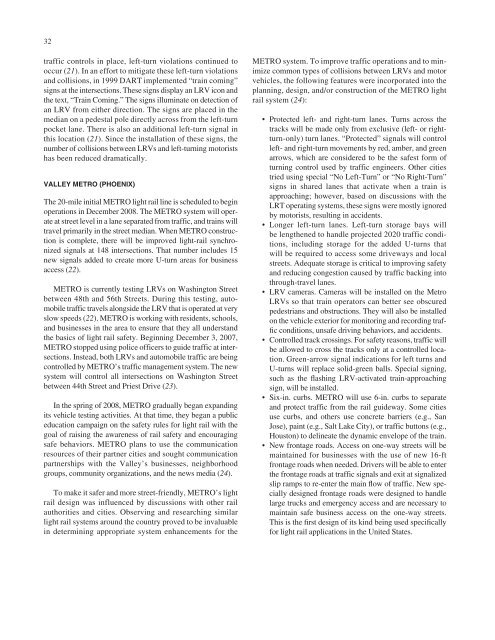Light Rail Vehicle Collisions with Vehicles at Signalized Intersections
Light Rail Vehicle Collisions with Vehicles at Signalized Intersections
Light Rail Vehicle Collisions with Vehicles at Signalized Intersections
- No tags were found...
You also want an ePaper? Increase the reach of your titles
YUMPU automatically turns print PDFs into web optimized ePapers that Google loves.
32traffic controls in place, left-turn viol<strong>at</strong>ions continued tooccur (21). In an effort to mitig<strong>at</strong>e these left-turn viol<strong>at</strong>ionsand collisions, in 1999 DART implemented “train coming”signs <strong>at</strong> the intersections. These signs display an LRV icon andthe text, “Train Coming.” The signs illumin<strong>at</strong>e on detection ofan LRV from either direction. The signs are placed in themedian on a pedestal pole directly across from the left-turnpocket lane. There is also an additional left-turn signal inthis loc<strong>at</strong>ion (21). Since the install<strong>at</strong>ion of these signs, thenumber of collisions between LRVs and left-turning motoristshas been reduced dram<strong>at</strong>ically.VALLEY METRO (PHOENIX)The 20-mile initial METRO light rail line is scheduled to beginoper<strong>at</strong>ions in December 2008. The METRO system will oper<strong>at</strong>e<strong>at</strong> street level in a lane separ<strong>at</strong>ed from traffic, and trains willtravel primarily in the street median. When METRO constructionis complete, there will be improved light-rail synchronizedsignals <strong>at</strong> 148 intersections. Th<strong>at</strong> number includes 15new signals added to cre<strong>at</strong>e more U-turn areas for businessaccess (22).METRO is currently testing LRVs on Washington Streetbetween 48th and 56th Streets. During this testing, automobiletraffic travels alongside the LRV th<strong>at</strong> is oper<strong>at</strong>ed <strong>at</strong> veryslow speeds (22). METRO is working <strong>with</strong> residents, schools,and businesses in the area to ensure th<strong>at</strong> they all understandthe basics of light rail safety. Beginning December 3, 2007,METRO stopped using police officers to guide traffic <strong>at</strong> intersections.Instead, both LRVs and automobile traffic are beingcontrolled by METRO’s traffic management system. The newsystem will control all intersections on Washington Streetbetween 44th Street and Priest Drive (23).In the spring of 2008, METRO gradually began expandingits vehicle testing activities. At th<strong>at</strong> time, they began a publiceduc<strong>at</strong>ion campaign on the safety rules for light rail <strong>with</strong> thegoal of raising the awareness of rail safety and encouragingsafe behaviors. METRO plans to use the communic<strong>at</strong>ionresources of their partner cities and sought communic<strong>at</strong>ionpartnerships <strong>with</strong> the Valley’s businesses, neighborhoodgroups, community organiz<strong>at</strong>ions, and the news media (24).To make it safer and more street-friendly, METRO’s lightrail design was influenced by discussions <strong>with</strong> other railauthorities and cities. Observing and researching similarlight rail systems around the country proved to be invaluablein determining appropri<strong>at</strong>e system enhancements for theMETRO system. To improve traffic oper<strong>at</strong>ions and to minimizecommon types of collisions between LRVs and motorvehicles, the following fe<strong>at</strong>ures were incorpor<strong>at</strong>ed into theplanning, design, and/or construction of the METRO lightrail system (24):• Protected left- and right-turn lanes. Turns across thetracks will be made only from exclusive (left- or rightturn-only)turn lanes. “Protected” signals will controlleft- and right-turn movements by red, amber, and greenarrows, which are considered to be the safest form ofturning control used by traffic engineers. Other citiestried using special “No Left-Turn” or “No Right-Turn”signs in shared lanes th<strong>at</strong> activ<strong>at</strong>e when a train isapproaching; however, based on discussions <strong>with</strong> theLRT oper<strong>at</strong>ing systems, these signs were mostly ignoredby motorists, resulting in accidents.• Longer left-turn lanes. Left-turn storage bays willbe lengthened to handle projected 2020 traffic conditions,including storage for the added U-turns th<strong>at</strong>will be required to access some driveways and localstreets. Adequ<strong>at</strong>e storage is critical to improving safetyand reducing congestion caused by traffic backing intothrough-travel lanes.• LRV cameras. Cameras will be installed on the MetroLRVs so th<strong>at</strong> train oper<strong>at</strong>ors can better see obscuredpedestrians and obstructions. They will also be installedon the vehicle exterior for monitoring and recording trafficconditions, unsafe driving behaviors, and accidents.• Controlled track crossings. For safety reasons, traffic willbe allowed to cross the tracks only <strong>at</strong> a controlled loc<strong>at</strong>ion.Green-arrow signal indic<strong>at</strong>ions for left turns andU-turns will replace solid-green balls. Special signing,such as the flashing LRV-activ<strong>at</strong>ed train-approachingsign, will be installed.• Six-in. curbs. METRO will use 6-in. curbs to separ<strong>at</strong>eand protect traffic from the rail guideway. Some citiesuse curbs, and others use concrete barriers (e.g., SanJose), paint (e.g., Salt Lake City), or traffic buttons (e.g.,Houston) to deline<strong>at</strong>e the dynamic envelope of the train.• New frontage roads. Access on one-way streets will bemaintained for businesses <strong>with</strong> the use of new 16-ftfrontage roads when needed. Drivers will be able to enterthe frontage roads <strong>at</strong> traffic signals and exit <strong>at</strong> signalizedslip ramps to re-enter the main flow of traffic. New speciallydesigned frontage roads were designed to handlelarge trucks and emergency access and are necessary tomaintain safe business access on the one-way streets.This is the first design of its kind being used specificallyfor light rail applic<strong>at</strong>ions in the United St<strong>at</strong>es.












